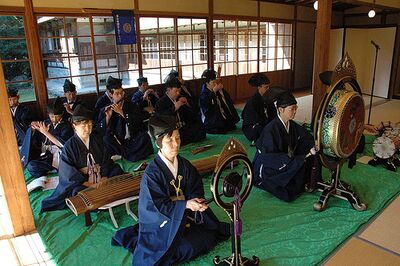Difference between revisions of "Gagaku"
m (not really art or architecture) |
|||
| Line 2: | Line 2: | ||
*''Japanese'': 雅楽 ''(gagaku)'' | *''Japanese'': 雅楽 ''(gagaku)'' | ||
| − | ''Gagaku'' is the classical court music of the Japanese Imperial court. It derives significantly from continental court music, and was adopted by the Japanese court as the official genre or style of court music in [[701]]. | + | ''Gagaku'' is the classical court music of the Japanese Imperial court. It derives significantly from continental court music, and was adopted by the Japanese court as the official genre or style of court music in [[701]]. |
| − | ''Gagaku'' is divided into two sub-categories, representing the two main threads of continental influence. Musical elements derived from Chinese influence are known as ''Tôgaku'' ([[Tang Dynasty|Tang]] music) and those from Korean influence ''komagaku'' ([[Koryo]] music). | + | ''Gagaku'' is divided into two sub-categories, representing the two main threads of continental influence. Musical elements derived from Chinese influence are known as ''Tôgaku'' ([[Tang Dynasty|Tang]] music) and those from Korean influence ''komagaku'' ([[Koryo]] music). With the influence and incorporation of native Japanese elements, ''gagaku'' is said to have developed into its mature form in the 10th century. |
Instruments used in ''gagaku'' include the [[biwa]] (a stringed lute), a variety of flutes including the ''[[sho|shô]]'', ''[[ryuteki|ryûteki]]'', ''[[hichiriki]]'', and ''[[komabue]]'', and a variety of drums, including the ''[[kakko]]'' and ''[[tsuridaiko]]'', as well as bells, gongs, and occasionally ''[[koto]]''. Performances are often accompanied by masked & costumed dances. | Instruments used in ''gagaku'' include the [[biwa]] (a stringed lute), a variety of flutes including the ''[[sho|shô]]'', ''[[ryuteki|ryûteki]]'', ''[[hichiriki]]'', and ''[[komabue]]'', and a variety of drums, including the ''[[kakko]]'' and ''[[tsuridaiko]]'', as well as bells, gongs, and occasionally ''[[koto]]''. Performances are often accompanied by masked & costumed dances. | ||
| + | |||
| + | ''Gagaku'' as performed by musicians of the [[Imperial Household Agency]] was named an Intangible [[Important Cultural Property]] in 1955, and in 2009 was named an important Intangible Cultural Heritage by UNESCO. | ||
{{stub}} | {{stub}} | ||
| Line 12: | Line 14: | ||
==References== | ==References== | ||
*Gallery labels, Metropolitan Museum of Art. | *Gallery labels, Metropolitan Museum of Art. | ||
| + | *Gallery labels, Tokyo Imperial Palace.[https://www.flickr.com/photos/toranosuke/18200814551/sizes/k/] | ||
[[Category:Poetry and Theater]] | [[Category:Poetry and Theater]] | ||
[[Category:Nara Period]] | [[Category:Nara Period]] | ||
[[Category:Heian Period]] | [[Category:Heian Period]] | ||
Revision as of 00:14, 7 June 2015
- Japanese: 雅楽 (gagaku)
Gagaku is the classical court music of the Japanese Imperial court. It derives significantly from continental court music, and was adopted by the Japanese court as the official genre or style of court music in 701.
Gagaku is divided into two sub-categories, representing the two main threads of continental influence. Musical elements derived from Chinese influence are known as Tôgaku (Tang music) and those from Korean influence komagaku (Koryo music). With the influence and incorporation of native Japanese elements, gagaku is said to have developed into its mature form in the 10th century.
Instruments used in gagaku include the biwa (a stringed lute), a variety of flutes including the shô, ryûteki, hichiriki, and komabue, and a variety of drums, including the kakko and tsuridaiko, as well as bells, gongs, and occasionally koto. Performances are often accompanied by masked & costumed dances.
Gagaku as performed by musicians of the Imperial Household Agency was named an Intangible Important Cultural Property in 1955, and in 2009 was named an important Intangible Cultural Heritage by UNESCO.
References
- Gallery labels, Metropolitan Museum of Art.
- Gallery labels, Tokyo Imperial Palace.[1]
